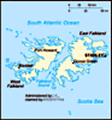Advertisement
Published: February 11th 2009
We left the hotel at seven for flight to Ushuaia, in the far south of the country, from which 95% of Antarctic expedition ships depart. We had been to Ushuaia several years before when we finished a driving trip through southern Patagonia here; it is a pleasant own of 60,000 or so whose culinary claim to fame is its Patagonian baby lamb rack-roasted over a charcoal fire. By noon we were digging into this finger-licking delight at one of the specialty restaurants on the main street, Avenida San Martin. Afterwards we had time for a short walk and some duty-free shopping before meeting up to board the Minerva in mid-afternoon.
We had chosen Minerva based on the recommendation of friends who had sailed aboard her, as well as an assessment of other ships doing the route we wanted to take - covering the Falkland Islands, South Georgia and the Antarctic Peninsula. She is a large and comfortable four-star ship that carries about 400 passengers during the northern summer, cruising the Mediterranean and other popular destinations. During the Austral summer, however, she goes into expedition mode, carrying no more than 200 passengers, a top-notch expedition crew, and a dozen Zodiacs to
facilitate fast landings. Given Lisa’s proclivity to seasickness we also thought that a larger vessel with stabilisers would offer a smoother passage in the rough weather the South Atlantic is prone to.
With a feeling of relief we unpacked in our spacious Bridge Deck balcony suite, knowing we wouldn’t have to pack again for sixteen days. Then we dealt with admin such as deciding where we wanted to go when in Port Stanley, arranging internet access, and attending the various ship and safety briefings. Given how much we seemed to be eating, a light selection of food from the buffet in the Veranda restaurant seemed more in order than a sit-down dinner in the main dining room.
We set sail after dinner in a chilly, drizzly twilight, quickly leaving the twinkling lights of Ushuaia behind us as we headed east down the Beagle Channel towards the Atlantic Ocean at the Minerva’s cruising speed of 15 knots.
During the night we passed the eastern tip of Tierra del Fuego, changed course to the northeast and broke out into open sea. The ship was pitching moderately in the ocean swell and Lisa, of course, was not feeling great although
the 50mg doses of Stugeron I had put her on were clearly a great help. I spent time out on the stern deck photographing some of the petrels and albatrosses flying across our wake and quickly realised that trying to focus on flying birds using a 400mm lens on a rolling deck is an art that clearly would take a bit of practice. There was also a useful lecture at which naturalist Patricia Silva described the birds we were most likely to see over the next couple of weeks.
In the late morning Captain John Moulds and Expedition Director Lou Sanson called a meeting of all passengers to brief us on a significant weather change. The situation was that a large but fast morning low pressure area had developed to the north, and that it was forecast to deliver Force 12 (hurricane-force) winds of over 60 knots by Sunday afternoon in the vicinity of the Falklands. At this time our current plan would have had us at anchor off West Falkland doing Zodiac landings! Our position there would be very exposed to north-westerly winds and if we tried to do a morning landing there the Minerva would then have to run out to sea to ride out the storm - a strategy that would be immensely uncomfortable for everyone on board, not to mention any risk inherent in sailing into hurricane-force winds. John and Lou had developed a Plan B, which was to go directly to Stanley and take shelter in Port William Sunday morning - the peak winds were predicted from 1pm Sunday for about twelve hours; assuming the storm passed as forecast, Monday’s Port Stanley schedule would stand as planned. The great disappointment was missing our day of wildlife and scenery in West Falkland and the Zodiac landings there, but our change of plan was clearly the right decision.
After lunch I went to the gym (quite hard to stay on the treadmill as the ship pitched and rolled!) while Lisa slept off her seasickness.
Lisa managed to get upright for the Captain’s welcoming cocktail and dinner for which we were guests at the Captain’s table. As we were to discover that night, and throughout the voyage, John Moulds was a terrific Captain, personable and amusing and an enthusiastic and skilled Antarctic sailor. He told us he had been at sea from the age of 16, and before that had spent four years (from age 7 to 11) at school in Singapore - living at Seletar Air Base where his father was stationed with the RAF. It was a very pleasant evening, and we enjoyed meeting Steven and Anita Segal and their sons Michael and Matt from Los Angeles, and Milt and Gerry Lumpkin from Redmond, WA. After dinner John joined Lisa and me in the smoking room where we swapped stories about Singapore and life at sea. By then the sea had calmed down considerably as we had slipped under the lee of East Falkland some twenty miles to the north of us, so Lisa was feeling quite herself again.
Next ➤ ➤
Advertisement
Tot: 0.1s; Tpl: 0.011s; cc: 13; qc: 23; dbt: 0.0574s; 1; m:domysql w:travelblog (10.17.0.13); sld: 1;
; mem: 1.1mb







